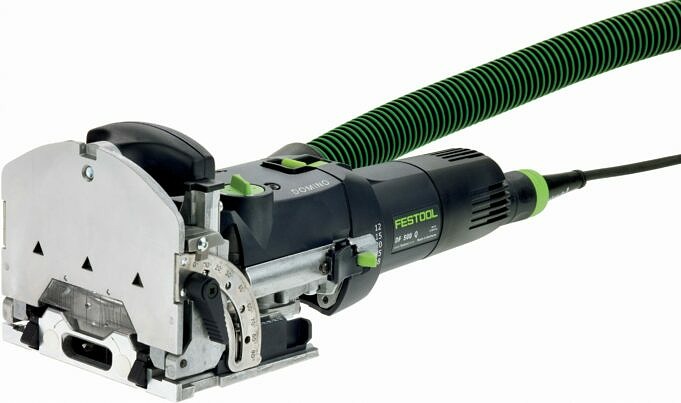While my fellow attendees were leaving the Festool Editors Event I was able to stay. Im glad I did because Steve Bace, Festools Training Manager who opened the United Statess first training center in Henderson, Nev., started explaining some of the finer points of the Domino.
There are three areas Domino owners can adjust on their tool. The first is the clear plastic-like plate (the site gauge) thats attached to the fence. Two small screws loosen the piece and adjustment is side-to-side to align the centerline of the plate with two other marks on the tool , one is the v-shaped ridge on the tool, the other is the point of the center triangle. Here’s a tip: If you attach the retractable pins to the edge, the edge will align with the point at which the triangle closest to it (the triangle is known as a verification window). This is a great method to double-check that you have the tool positioned correctly.
The second area to which to make adjustments is the correlation of the adjustable fence to the baseplate of the Domino. Bace suggested that you test the relationship by using a few pieces of brass bar stock. Loosen the screw just above the gauge pointer, set the fence on the brass stock and push the tools baseplate flat to the bench. You will not get a good reading if there is any junk underneath the baseplate. After everything is aligned, tighten the screw.
The last adjustment is to one retractable pin. The key to accuracy is having the distance from the center of the cut to the inside edge of the pins equal. The slot locations will not line up if this distance is too far apart. To change the relationship simply , and carefully, I might add , use a screwdriver to turn the pin housing. That housing is eccentric. Small adjustment is all it takes if your pins are out of alignment. Bace said that he has never had to worry about that.
For adjustments other than these, its suggested you return the tool to Festool to have it repaired or adjusted.
Here’s one thing you might do that may lead to a misalignment without realizing it. Many of us are large, muscular men. We make sure the dog doesn’t get in our way. Im guilty. I don’t want my router bits to slip or my fence to move. However, if the Domino cutters are changed and the Domino cutters are tightened so that they won’t move, it could affect the accuracy of the cut. Over-tightening may cause the turret-like mechanism of the four screws to shift slightly. This can alter the shape of the mortising bits, which is not good. You would really have to be going at this with force to affect the mechanism, but if youre that burly-man, it might happen. Now, tighten your fingers and let Domino take care of the rest.
Ive got one additional quick tip. Use the Domino to set loose tenons into a 45. cut, set the adjustable fence angle from 90? Reduce the adjustable fence angle from 90? to 45? and then lower the fence to its lowest setting. Reversing the steps keeps the fence higher (and the resulting cut lower) by almost 6mm. This allows you to cut through stock up to 3/10 cm depending on the depth. Bace also recommends that you use 5mm x30mm Dominos to support any angled joinery.
I was given another neat tip involving the Domino and particleboard. If you find this interesting, I’ll pass it along to you. Also, I will give you a deeper look at the Festool routers in my next Festool article. Also, I picked up a neat idea from the Wood Whisperer, Marc Spagnuolo, about routers and inlay. Check back for that.
If you have any tips or tricks for Domino users, please leave a comment on this blog. As I become more familiar with the tool, I would like to share my knowledge.
And for more in-depth information on the Domino adjustments mentioned above, check this link. Its not from Festool so neither Festool nor I guarantee the information. But what I see looks good.



